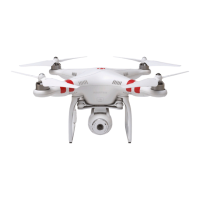©
2014 DJI. All Rights Reserved.
25
Flight
Once pre-ight preparation is complete, it is recommended to carry out the tasks in the Phantom Pilot Training Guide
to prepare for more complex ight maneuvers and learn to y safely. Ensure that all ights are carried out in a suitable
location.
Flight Environment Requirements
(1) Do not use the aircraft in severe weather conditions. These include wind speed exceeding category 4, snow, rain
and smog.
(2) Fly in open elds as high buildings or steel structures may affect the accuracy of the onboard compass.
(3) Keep the Phantom away from obstacles, crowds, high voltage power lines, trees or bodies of water when in ight.
(4) Reduce the chance of electromagnetic interference by not ying in areas with high levels of electromagnetism,
including base stations or radio transmission towers.
(5) The Phantom cannot operate within the polar areas.
(6) Do not y the aircraft within no-y zones specied by local laws and regulations.
Preight Checklist
(1) Remote Control, smart battery, Range Extender and smartphone are fully charged.
(2) Propellers are mounted correctly.
(3) Gimbal clamp has been removed.
(4) Damping absorbers are in good condition, not broken or worn.
(5) Anti-drop kits have been mounted correctly.
(6) Camera lens cap has been removed.
(7) Micro-SD card has been inserted if necessary.
(8) Gimbal is functioning as normal.
(9) Motors can start and are functioning as normal.
(10) DJI VISION App can connect to the camera.
1 Calibrating the Compass
IMPORTANT: Make sure to calibrate the compass in every new flight location. The compass is very sensitive to
electromagnetic interference, which can cause abnormal compass data leading to poor ight performance or even ight
failure. Regular calibration is required for optimum performance.
DO NOT calibrate your compass where there is a chance of strong magnetic interference, such as magnetite,
parking structures, and steel reinforcements underground.
DO NOT carry ferromagnetic materials with you during calibration such as keys or cellular phones.
DO NOT calibrate beside massive metal objects.
1.1Calibration Procedures
Choose an open space to carry out the following procedures. Watch the Phantom 2 Vision+ quick start video for more
details.
Figure 48
Start cali.
LED Flight
Indicator
Position-1
Position-3
Positon-1->Positon-3
->Positon1 Flip once
Start horizontal calibratio
LED Flight Indicator
Solid Yellow
Start vertical calibratio
LED Flight Indicator
Solid Green
Succeed
Normal LED
Fail
Red, Yellow
ashing in turn
360°Rotate the aircraft
horizontally
360°Rotate the aircraft
vertically (Nose downward)
Quickly ip the switch S1
Position-1
Position-3
Position-1->Position-3->Position1
Flip 5 times or above, or tap
"Compass Calibration" in DJI
VISION APP
Calibrating the Compass
Re-calibrate

